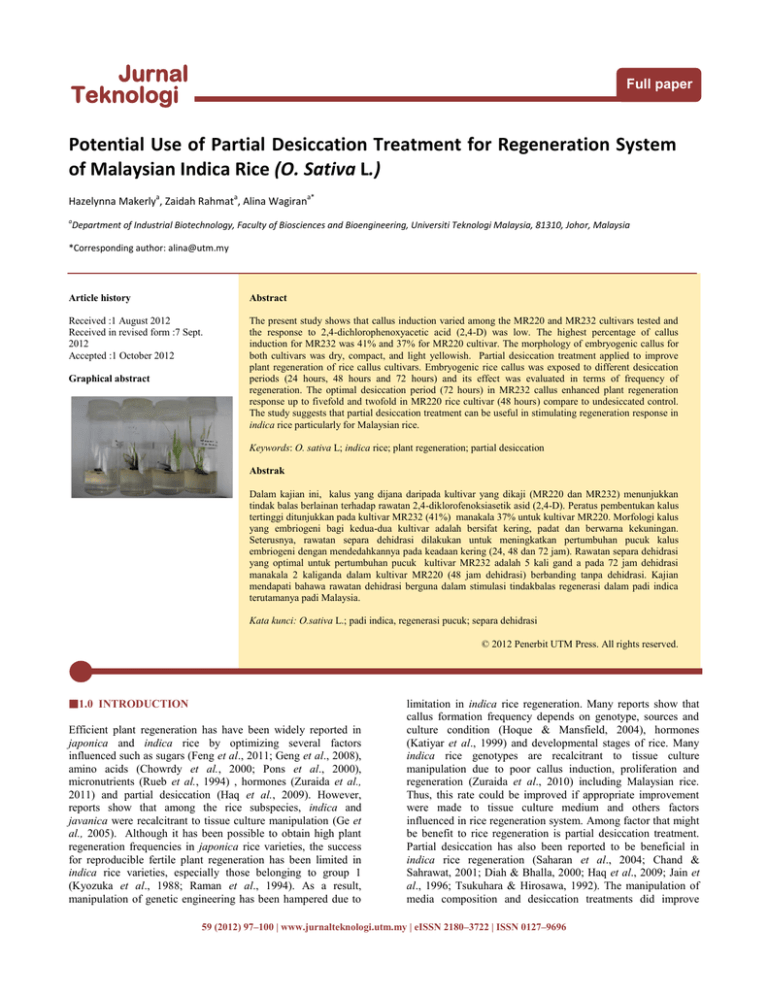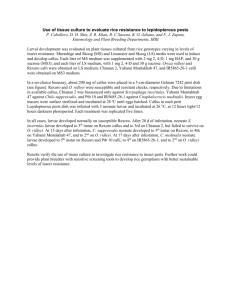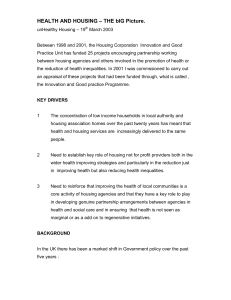Jurnal Teknologi Potential Use of Partial Desiccation Treatment for Regeneration System (O. Sativa
advertisement

Jurnal Teknologi Full paper Potential Use of Partial Desiccation Treatment for Regeneration System of Malaysian Indica Rice (O. Sativa L.) a a a* Hazelynna Makerly , Zaidah Rahmat , Alina Wagiran a Department of Industrial Biotechnology, Faculty of Biosciences and Bioengineering, Universiti Teknologi Malaysia, 81310, Johor, Malaysia *Corresponding author: alina@utm.my Article history Abstract Received :1 August 2012 Received in revised form :7 Sept. 2012 Accepted :1 October 2012 The present study shows that callus induction varied among the MR220 and MR232 cultivars tested and the response to 2,4-dichlorophenoxyacetic acid (2,4-D) was low. The highest percentage of callus induction for MR232 was 41% and 37% for MR220 cultivar. The morphology of embryogenic callus for both cultivars was dry, compact, and light yellowish. Partial desiccation treatment applied to improve plant regeneration of rice callus cultivars. Embryogenic rice callus was exposed to different desiccation periods (24 hours, 48 hours and 72 hours) and its effect was evaluated in terms of frequency of regeneration. The optimal desiccation period (72 hours) in MR232 callus enhanced plant regeneration response up to fivefold and twofold in MR220 rice cultivar (48 hours) compare to undesiccated control. The study suggests that partial desiccation treatment can be useful in stimulating regeneration response in indica rice particularly for Malaysian rice. Graphical abstract Keywords: O. sativa L; indica rice; plant regeneration; partial desiccation Abstrak Dalam kajian ini, kalus yang dijana daripada kultivar yang dikaji (MR220 dan MR232) menunjukkan tindak balas berlainan terhadap rawatan 2,4-diklorofenoksiasetik asid (2,4-D). Peratus pembentukan kalus tertinggi ditunjukkan pada kultivar MR232 (41%) manakala 37% untuk kultivar MR220. Morfologi kalus yang embriogeni bagi kedua-dua kultivar adalah bersifat kering, padat dan berwarna kekuningan. Seterusnya, rawatan separa dehidrasi dilakukan untuk meningkatkan pertumbuhan pucuk kalus embriogeni dengan mendedahkannya pada keadaan kering (24, 48 dan 72 jam). Rawatan separa dehidrasi yang optimal untuk pertumbuhan pucuk kultivar MR232 adalah 5 kali gand a pada 72 jam dehidrasi manakala 2 kaliganda dalam kultivar MR220 (48 jam dehidrasi) berbanding tanpa dehidrasi. Kajian mendapati bahawa rawatan dehidrasi berguna dalam stimulasi tindakbalas regenerasi dalam padi indica terutamanya padi Malaysia. Kata kunci: O.sativa L.; padi indica, regenerasi pucuk; separa dehidrasi © 2012 Penerbit UTM Press. All rights reserved. 1.0 INTRODUCTION Efficient plant regeneration has have been widely reported in japonica and indica rice by optimizing several factors influenced such as sugars (Feng et al., 2011; Geng et al., 2008), amino acids (Chowrdy et al., 2000; Pons et al., 2000), micronutrients (Rueb et al., 1994) , hormones (Zuraida et al., 2011) and partial desiccation (Haq et al., 2009). However, reports show that among the rice subspecies, indica and javanica were recalcitrant to tissue culture manipulation (Ge et al., 2005). Although it has been possible to obtain high plant regeneration frequencies in japonica rice varieties, the success for reproducible fertile plant regeneration has been limited in indica rice varieties, especially those belonging to group 1 (Kyozuka et al., 1988; Raman et al., 1994). As a result, manipulation of genetic engineering has been hampered due to limitation in indica rice regeneration. Many reports show that callus formation frequency depends on genotype, sources and culture condition (Hoque & Mansfield, 2004), hormones (Katiyar et al., 1999) and developmental stages of rice. Many indica rice genotypes are recalcitrant to tissue culture manipulation due to poor callus induction, proliferation and regeneration (Zuraida et al., 2010) including Malaysian rice. Thus, this rate could be improved if appropriate improvement were made to tissue culture medium and others factors influenced in rice regeneration system. Among factor that might be benefit to rice regeneration is partial desiccation treatment. Partial desiccation has also been reported to be beneficial in indica rice regeneration (Saharan et al., 2004; Chand & Sahrawat, 2001; Diah & Bhalla, 2000; Haq et al., 2009; Jain et al., 1996; Tsukuhara & Hirosawa, 1992). The manipulation of media composition and desiccation treatments did improve 59 (2012) 97–100 | www.jurnalteknologi.utm.my | eISSN 2180–3722 | ISSN 0127–9696 98 Hazelynna, Zaidah & Alina / Jurnal Teknologi (Sciences & Engineering) 59 (2012) Suppl 1, 97–100 Malaysia rice regeneration frequency as reported by Zuraida et. al, (2011; 2010). Therefore, since there are only a few reports on Malaysia rice regeneration system; this study presented here shows simple and practical techniques to improve regeneration. Thus, the objectives of this study was to investigate the role of 2,4-dichlorophenoxyacetic acid (2,4-D) to induce callus and different desiccation period on shoot formation. 2.0 MATERIALS AND METHODS 2.1 Plant Materials and Media The explants used in the present study were mature seed of Malaysia rice; MR220 and MR232 cultivars obtained from Malaysian Agricultural Research and Development Institute (MARDI), Seberang Prai, Penang, Malaysia. Mature rice seeds were de-husked and immersed in 100% (v/v) ethanol for 1 min. After that, the solution was discarded and replaced with 100% (v/v) Clorox supplemented with 2-3 drops of Tween-20 and incubated for 30 minutes. The seeds were rinsed three times by using sterile distilled water in order to remove all traces of disinfectant. The sterilized seed was then blot dried and used for callus induction experiments. For callus induction, the sterilized seeds were cultured on solidified MS basal medium (Murashige and Skoog, 1962) supplemented with 2.5 mg/L of 2,4dicholorophenoxyacetic acid (2,4-D) , 1.0 mg/L napthalene acetic acid (NAA), 15g/L sucrose, and 30 g/L phytagel as designated by MS2.4D. After 8 weeks, callus induction frequency and their morphology were recorded. The selected embryogenic callus was then used for regeneration study. For this purpose, embryogenic callus was subjected to different desiccation period and their performance will be evaluated in terms of regeneration percentage. Prior to plating the callus on sterile filter paper in empty petri dishes, calli were weighed before and after each treatment (24 hours, 48 hours and 72 hours) and then sealed with parafilm. The 0 hours treatment was used as control. The desiccation percentage was calculated by the following formula. Desiccation percentage: Fresh callus weight-desiccated callus weight Fresh callus weight All the culture was incubated and kept in the dark at 2527°C and each treatment have two replicates. Then, the desiccated calli were transferred on solidified MS basal media containing 1.0 mg/L NAA and 1.0 mg/L BAP for shoot regeneration. The cultures were incubated at 25-27°C under cool white fluorescent lamp at 31.2 μmol m-2s1. Observation based on the percentage of shoot regeneration was determined at the end of study. Each treatment contained 2 replicates with 10 seeds per plate and each experiment was repeated two times. 2.2 Statistical Analysis The results were further analyzed using statistical software (SPSS 15.0 for Windows). Two tests, One-way Analyses of Variance (ANOVA) and Tukey post hoc test were used to determine the significant difference between the treatment and also between the rice cultivars, MR220 and MR232. 3.0 RESULTS AND DISCUSSIONS 3.1 Callus Induction Surface sterilized seeds was cultured on solidified MS medium supplemented with 2.5 mg/L 2,4-D and 1 mg/L NAA and the callus formation were observed after two weeks. The callus was developed from the scutellum part of the rice seeds and can be observed at day ten for both cultivars. Then the cell proliferates to produce callus at day 21 (Figure 1A and B). Both cultivars show similar characteristics which are dry, compact, and light yellowish in color. Callus induction from both cultivars shows different percentage of callus formation. Rice cultivar of MR 220 has higher mean frequency of callus formation (41.67%) compared to MR232 at 37.67%. A B Figure 1 Callus induction after 21 days of culture on MS2.4D for MR220 (A) and MR232 (B) (Scale bar = 8 mm) According to Zuraida et. al. (2010), the frequency of callus formation depends on the genotype and most indica rice cultivars have poor callus induction. The present study shows that the use of 2,4-D alone at lower concentration unfavorable as shown by callus percentage compare to combination with NAA (5-10mg/L) for MR232 cultivar (Zuraida et al., 2011). Previous study also stated that the success of reproducing fertile plant regeneration has been limited in indica rice variety, especially those belonging to group 1 (Kyozuka et al., 1994). Based on the morphology of indica rice, callus can be classified into four types which are I, II, III, and IV. For type I, the calli were compact and white or cream color. Usually callus type I have outstanding regeneration. Type II consists of yellow color of organized calli which have fine regeneration. Callus type III were yellow or brown unorganized calli which turn brown/dark and necrotic/dead. For type IV, callus was highly unorganized and white, cream or brown in color. This callus gave rise only to the roots (Visarada et al., 2002). The morphology of embryogenic callus in the present study was dry, compact, and light yellowish in color in accordance to above statement for Type I. 3.2 Desiccation and Shoot Regeneration The present study shows that callus derived from mature seed of 2 cultivars was subjected to 24 hours, 48 hours and 72 hours desiccation periods. The term desiccation percentages indicate the percentage loss in callus fresh weight before and after desiccation. The percentage of desiccation treatment was different among the 2 cultivars tested. There were differences in the desiccation percentages of calluses with the partial desiccation treatment among the cultivars tested. MR220 dehydrated callus exhibit lower percentage of desiccation 99 Hazelynna, Zaidah & Alina / Jurnal Teknologi (Sciences & Engineering) 59 (2012) Suppl 1, 97–100 compare to MR232 cultivars with similar desiccation duration (Table 1). A B C D Table 1 The frequency of shoot regeneration by indica rice cultivars MR220 and MR232 after desiccation treatment Cultivar Desiccation treatment (hours) Weight of calli before desiccation (g) Weight of calli after desiccation (g) Percentage of desiccation (%) MR 220 0 0.4407 0.4407 0.00 24 0.9859 0.9289 5.78 48 0.7211 0.6534 9.39 72 0.3320 0.2924 11.93 0 0.5138 0.5138 0.00 24 0.2655 0.196 26.17 48 0.5756 0.4064 29.40 72 0.4181 0.2443 41.57 MR 232 The effect of desiccation treatment on callus morphology was detrimental and probably led to callus damage as shown in Figure 2. The callus became smaller and dry as water was drawn out from the cell. The degrees of water loss for both cultivars tested as shown by desiccation percentage were different with same desiccation duration. A B C Figure 2 The morphology of callus after different desiccation period; (A) 24 hours, (B) 48 hours, (C) 72 hours (Scale bar = (A) 4 mm, (B) 2 mm, (C) 4 mm Fourty eight desiccation treatments proved optimal as this treatment shows up to 58.34% regeneration response in MR220 cultivar and then decreased to 10% when exposed to 72 hour desiccation (Table 2). There are no significant differences (P<0.05) between treatment of 24 hours and without treatment. The present study also shows that longer desiccation period decrease shoot regeneration. However, desiccation period of 72 hours shows higher shoot regeneration (55%) for MR232 cultivar, while no shoot formation was observed for treatment without desiccation (0 hour). After one month, the in vitro shoot regeneration and elongation was shown in Figure 3. Figure 3 Shoot regeneration in vitro of rice cultivar with different desiccation period after 4 weeks in culture; (A) 0 hour, (B) 24 hours, (C) 48 hours, (D) 72 hours (Scale bar = 1 cm) Many researchers have focused on modifying culture conditions in regeneration procedures to increase plantlet regeneration frequency of rice calli such as hormone, sugars, solidifying agents basal salt and vitamin, partial desiccation treatment and genotypes (Feng et al., 2011; Sahoo et al., 2011; Haq et al., 2009; Yan et al., 2009; Liu et al., 2004). According to Ikram-ul-Haq et. al. (2009), desiccation treatment before super basmati rice regeneration was observed to be more effective than callus culture without desiccation treatment. In agreement with this, the present study also employed the same procedure for MR232 rice cultivars where regeneration frequency was observed at 55% at optimal desiccation period. This may be caused by changes in translatable mRNAs and elicited modification in protein synthesis as reported by Rance et al., (1994). Recent study indicates that desiccation can activate genes of late embryogenesis abundant (LEA) protein (Bartels, 2005). Plant LEA proteins has protective role in embryo tissue during seed maturation in response to osmotic stress. In this study, the partial desiccation procedures might be expected to induce somatic embryo towards shoot development. Therefore, each cultivar of indica rice showed different response toward desiccation treatment because of the changes that occur at the molecular level. Additionally, Saharan et al., (2004) found that optimal desiccation period at 48 hours was benefit in improvement of shoot regeneration in indica rice variety HKR46. Stimulation of regeneration response by partial desiccation has been reported in japonica suspension rice cell derived callus which resulted in enhanced plant regeneration (Wagiran et al., 2008). This improvement in regeneration potential might be because of increase of absisic acid (ABA) in desiccated callus (Yang et al., 1999) and improvement of oxygen supply (Jain et al., 1996). The present study shows that exposure of partial desiccation to Malaysian rice callus may play important role in promoting regeneration especially in rice with low callus induction. 100 Hazelynna, Zaidah & Alina / Jurnal Teknologi (Sciences & Engineering) 59 (2012) Suppl 1, 97–100 Table 2 Effect of desiccation treatments on the shoot regeneration frequency of callus MR220 and MR232 cultivar [9] Regeneration frequency Desiccation (hour) [8] period MR220 MR232 0 20.00 ± 0.00a 0.00 ± 0.00a 24 20.00 ± 0.00a 10.00 ± 10.00ab [10] [11] [12] 58.35 ± 8.34b 48 12.50 ± 12.50ab [13] 10.00 ± 10.00a 72 55.00 ± 7.07b [14] Significant difference at 0.05 level (ANOVA) 0.022 0.033 *the mean difference is significant at the p=0.05 level *a, ab and b represent different significant homogenous subsets in the increasing order of the mean value. Groups in the different homogenous subsets (alphabet: a, b, ab) differ significantly from each other while groups in the same homogenous subset do not differ significantly. 4.0 CONCLUSIONS High percentage of callus induction is considered the most critical step to achieve efficient shoot regeneration. The present studies show that induction of callus and shoot regeneration varied depending on cultivars and duration of partial desiccation. The data presented here could serve as preliminary finding for achieving better shoot regeneration to other Malaysia rice system. [15] [16] [17] [18] [19] [20] [21] Acknowledgement The author would like to thank MARDI, Malaysia for providing rice seeds and Faculty of Biosciences and Bioengineering, UTM Skudai, Malaysia for financial assistance. References [1] [2] [3] [4] [5] [6] [7] Bartel, D. 2005. Desiccation Tolerant Studied in the Resurrection Plant Craterostigma Plantagineum I. Integ. Comp. Biol. 45: 696–701. Chand, S. and Sahrawat, A.K. (2001). Stimulatory Effect of Partial Desiccation in Plant Regeneration in Indica Rice (Oryza sativa. L). Journal of Plant Biochemistry and Biotechnology. 10(1): 43–47. Chowdhry, C. N., Tyagi, A.K., Maheshwari, N. and Maheshwari, S. C. 2000. Effect of Proline and L-Tryptophan on Somatic Embryogenesis and Plantlet Regeneration of Rice (O. sativa L. cv Pusa 169. Plant Cell, Tissue and Organ Culture. 32(3): 357–361. Diah, A. and Bhalla, P.L. (2000). Plant Regeneration from Mature Embryo-Derived Callus of Australian Rice (Oryza Sativa L.) Varieties. Australian Journal of Agricultural Research. 51(2): 305–312. Feng, X., Zhao, P., Hao, J., Hu, J., Kang, D. and Wang, H. 2011. Effect on Sorbitol on Expression of Genes Involved in Regeneration of Upland Rice (O. sativa L.). Plant Cell, Tissue and Organ Culture. 106: 455–463. Ge X., Chu Z., Lin Y. and Wang S. 2006. A Tissue Culture System for Different Germplasms of Indica Rice. Journal of Cell Biology and Morphogenesis. 25:392–402. Geng, P., La, H., Wang, H. and Stevens, E.J.C. 2008. Effect of Sorbitol Concentration on Regeneration of Embryogenic Calli in Upland Rice Varieties (Oryza sativa L.). Plant Cell, Tissue and Organ Culture. 92(3): 303–313. [22] [23] [24] [25] [26] [27] [28] [29] Haq, I., Zhao, C. X., Mukhtar, Z., Jaleel, C. A. and Azooz, M. M. 2009. Effect of Physical Desiccation on Plant Regeneration Efficiency in Rice (Oryza sativa L.). Journal of Plant Physiology. 166: 1569– 1575. Higuchi, N. and Maeda, E. 1990. Enhanced Plant Regeneration in Rice Callus Culture Following Absisic Acids Treatment. Japan Journal of Crop Science. 59(2): 359–368. Hoque, M. E. and Mansfield, J. W. 2004. Effect of Genotype and Explants Age on Callus Induction and Subsequent Plant Regeneration from Root-Derived Callus of Indica Rice Genotype. Journal of Plant Cell and Organ Culture. 78: 217–223. Ikram-ul-Haq, Zhao C.X, Zahid M., Cheruth A.J. and Mohamed M.A. (2009). Effect of Physical Desiccation on Plant Regeneration Efficiency in Rice (Oryza Sativa L.) Variety Super Basmati. Journal of Plant Physiology. 16: 1568–1575. Jain, R.K., Jain, S. and Wu, R. 1996. Stimulatory Effect of Water Stress on Plant Regeneration in Aromatic Indica Rice Varieties. Plant Cell Reports. 15(6): 449–454. Katiyar, S.R., Chandel, G., Singh, P. and Pratibha, R. 1999. Genetic Variation and Effect of 2,4-D in In-Vitro Plant Regeneration in Indica Rice Ciltuvars. Oryza. 36: 254–256. Kyozuka, J., Otoo, E. and Shimamoto, K. 1988. Plant Regeneration From Protoplast of Indica Rice: Genotype Differences in Culture Response. Theor. Appl. Genet. 76: 887–890. Liu, Y. F., Liu, Y. Z., He, H., Wang, J. H., Li, L. and Li, X. F. 2004. Factor Influencing of Callus Induction and Plant Regeneration from Embryos in Indica Rice. Plant Physiology Communication. 40: 319– 322. Murashige, T. and Skoog, F. 1962. A Revised Medium for Rapid Growth and Bioassays with Tobacco Ttissue Cultures. Journal of Physiology Plant. 15: 473–497. Pons, M.J, Marfá, V., Melé, E. and Messeguer, J. 2000. Regeneration and Genetic Transformation of Spanish Rice Cultivars Using Mature Embryos. Euphytica. 114(2): 117–122. Raman, R., Chahal, G. S., Dhaliwal and H. S. 1994. Screening of Genotype for Callus Induction and Plant Regeneration in Rice. Crop Improvement. 21: 1–2. Rance, I. M., Tian W., Helena M., Alexandre de Kochko, Beachy R.N and Fauquet C. 1994. Partial Desiccation of Mature Embryo-Derived Calli, A Simple Treatment that Dramatically Enhances the Regeneration Ability of Indica Rice. Plant Cell Reports. 13: 647–651. Rueb, S., Leneman, M., Schilperoort, R.A. and Hensgen, L.A.M. 1994. Efficient Plant Regeneration Through Somatic Embryogenesis from Callus Induced on Mature Rice Embryos (Oryza sativa L). Plant Cell, Tissue and Organ Culture. 36(2): 259–264. Saharan, V., Yadav, R. C., Yadav, N. R. and Chapagain, B. P. 2004. High Frequency Plant Regeneration from Desiccated Calli of Indica Rice (Oryza Sativa L.). African Journal of Biotechnology. 3(5): 256– 259. Sahoo, K.K., Tripathi, A.K., Pareek, A., Sopory, S.K. and SinglaPareek, S.L. (2011). An Improved Protocol for Efficient Transformation and Regeneration of Diverse Indica Rice Cultivars. Plant Methods. 7:49–59. Tsukuhara, M. and Hirosawa, T. 1992. Simple Dehydration Treatment Promotes Plantlets Regeneration of Rice (O.Sativa L.) Callus. Plant Cell Reports. 13: 647–665. Visarada, K.B.R.S, Sailaja, M. & Sarma, N.P. 2002. Effect of Callus Induction Media on Morphology of Embryogenic Calli in Rice Genotypes. Biologia Plantarum. 45(4): 495–502. Wagiran, A., Ismil, I., Che Mohd Zain, C.R. & Abdullah, R. 2008. Improvement of Plant Regeneration from Embryogenic Suspension Cell Culture of Japonica Rice. Journal of Biological Sciences. 8: 570– 576. Yan, L. N., Li, X. and Cai, Q. S. 2009. Research in the Induction and Regeneration of Mature Embryo-Derived Calli from Rice Wugeng 3. Jiangsu Agriculture Science. 6: 67–67. Yang, Y-S., Zheng, Y-D., Chen, Y-L. & Jian, Y-Y. 1999. Improvement of Plant Regeneration from Long Term Cultured Calluses of Taipei 309, A Model Rice Variety in In Vitro Studies. Plant Cell, Tissue and Organ Culture. 57(3): 199–206. Zuraida A.R, Naziah B., Zamri Z. and Sreeramanan S. 2011. Efficient Plant Regeneration of Malaysian Indica Rice MR 219 and 232 via Somatic Embryogenesis System. Journal of Acta Physiol Plant. 3(5): 1913–1921. Zuraida A.R., Suri R., Zaliha W.S and Sreeramanan S. 2010. Regeneration of Malaysian Indica Rice (Oryza Sativa L.) Variety MR232 via optimised somatic embryogenesis system. Journal of Phytology. 2 (3): 30–38. 102 Hazelynna, Zaidah & Alina / Jurnal Teknologi (Sciences & Engineering) 59 (2012) Suppl 1, 97–100




